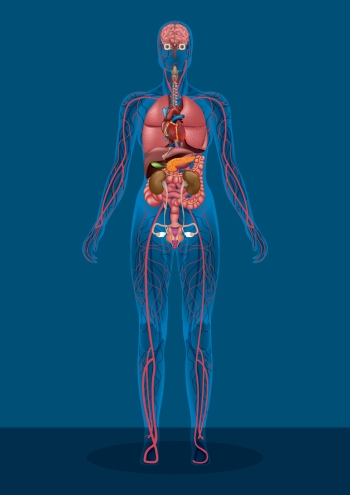
Are you someone who struggles with functional neurological disorder? Then this article is for you! Functional neurological disorder (FND) is a condition that causes disruptions in a person’s brain networks and nervous system functioning resulting in unwanted physical and/or neurological symptoms. Examples of symptoms may include uncontrolled movements, brain fog, cognitive functioning issues, vision or hearing issues, speech changes, seizures, tremors, and pain, numbness, or weakness in different areas of the body.
There is currently no known proven cause of FND, but it is widely believed that symptoms may be triggered or exacerbated by psychological distress resulting in a nervous system overload. When the nervous system becomes overloaded, the body may release built-up stress manifesting as FND symptoms. Our bodies are sensitive to our environment and have a memory of their own. They house not only our organs, but also our emotions. FND may be a sign that you are disconnected from your emotions or your needs. Over time, learning to listen to your body and regulate your nervous system can help with managing FND symptoms. This article is meant to help someone struggling with FND flare-ups reduce symptoms by resetting and calming the nervous system and rewiring the brain over time. You may follow these steps and repeat them as needed for managing FND symptoms.
Before diving in, it is important to understand that symptoms are not a sign of failure. Your symptoms are real and sometimes flare-ups will occur. These steps are meant to help manage symptoms and prevent the onset of flare-ups to increase quality of life. Though this article is meant to help, this should not be your only form of treatment. Exercises from this article should be utilized in conjunction with recommendations from a care team of medical and mental health care professionals.
Step One: Reset
Your nervous system is on overdrive! You are overloaded with stimuli, and your brain and body are trying to send you a message. Tap in and listen with curiosity and compassion. Your body has been through a lot and you deserve some rest. The reset protocol is meant to help release built-up stress stored in the body. Complete these steps for 3 days to reset a flooded nervous system.
First, it might sound crazy, but trust the process – talk to your brain! Remind yourself that you are safe. Thank your brain for letting you know that you need help and for all of its hard work. Tell your brain you are listening now and will take care of yourself. Remind your brain that you are in charge. Repeat these mantras at least once a day.
Incorporate self-care exercises (at least 3 a day) to release and recharge. Below are some examples of exercises to calm the nervous system.
Have a dance party! Turn on your favorite playlist at home and have fun moving and grooving.
Get a massage or give yourself one, whether with a massage gun, your hands, a foam roller, or a massage ball.
Practice a body scan meditation. There are video and audio guides online if you prefer to be led through the experience. Begin with feeling your breath, and then noticing different sensations in your body starting from your toes all the way to the top of your head. Go slowly and breathe the entire time.
Do some gentle stretching and deep breathing.
Relax under a weighted or heated blanket. Enhance the experience with calm instrumental music, a calming face mask, aroma therapy, or a hot cup of herbal tea.
Get outside if you are able to and sit and relax in nature. Alternatively, take a relaxing walk. Visit a local park, coffee shop, or just explore your surroundings.
Journal for 30 minutes. Find a topic, explore what’s on your mind, or free flow.
Take a shower and switch back and forth from hot to cold water. This helps your nervous system regulate.
These exercises are meant to help relieve nervous system overload. Incorporating some of these exercises into daily life, especially during high-stress periods, can help reset and regulate your nervous system.
Step Two: Symptom Management
Learn your warning signs. Begin to understand triggers for your FND symptoms and recognize an oncoming episode before it starts. Track your symptoms using a body diagram. What happens first? Describe and map those sensations and feelings on the diagram. What happens next? How does the FND cycle continue to play out? What is going on for you before symptoms occur? Log what happens and begin to notice patterns in your cycles. Go a step further and alter your environment and behaviors to prevent symptom onset once you have identified your triggers.
Listen to your body. Feeling an onset? Tap in and give your body what it is asking for. Do you need to relax? Exercise? Drink water? Become attuned to what you need and find what works for you.
Notice how you are reacting to your symptoms. Practice acknowledging them without judgment and remaining calm. Sometimes symptoms will occur and that is okay. You are safe. You have tools to manage your symptoms. Remind yourself that you are in control and practice your mantras.
Having a flare-up? If you can, take a 5-10 minute break from whatever you are doing and choose an exercise from the list below to help with managing FND symptoms.
Reduce sensory inputs. Turn off the lights and find a quiet, alone space to rest.
Drink an ice-cold beverage, rub an ice cube on your wrist, gargle water, suck on a sour candy, or breathe in aromatherapy. This can help to slow your heart rate and redirect your nervous system.
Engage all your senses in the 5-4-3-2-1 method: Start by noticing 5 things you can see, 4 things you can feel/touch, 3 things you can hear, 2 things you can smell, and 1 thing you can taste. This exercise helps ground you in your body and the present moment.
Do something intentional with a part of your body experiencing a symptom. For example, press down on a shaking hand or deliberately swing a jerking arm.
Try deep breathing and focus your breath on a specific part of the body experiencing a symptom. Visualize breathing into that body part and imagine oxygen flooding to that area.
Practice progressive muscle relaxation. Start from the top of your head and move down to your toes, intentionally engaging each muscle for 5 seconds and then relaxing that muscle.
Step Three: Rewire
FND symptoms occur when your autonomic nervous system is activated and you enter fight/flight/freeze mode. Without acknowledging how hard your body is working and actively calming your nervous system down, your brain will continue to overactivate your nervous system, and your body will release this energy through FND symptoms. Over time, the goal is to moderate your nervous system activity.
The main regulator of your brain-body connection is the vagus nerve. The vagus nerve is the largest nerve in the body, sending signals between your brain and organs and controlling many of your body's functions. The vagus nerve literally connects the brain to the body, originating in the brain stem and branching out through the chest and abdomen areas, carrying signals between our brain, heart, and digestive system. The vagus nerve is a key part of the parasympathetic nervous system, which helps to calm the body by bringing it out of fight/flight/freeze mode and into rest and digest mode to help you conserve energy.
Rewiring exercises are meant to strengthen the vagus nerve. By strengthening or “working out” the vagus nerve, you can train it to send relaxation signals and balance your nervous system more easily. Regularly practicing grounding or calming exercises that engage the parasympathetic nervous system will rewire your brain to become less easily activated and begin to moderate your nervous system activity automatically. Eventually, regularly exercising the vagus nerve can help with managing FND symptoms.
Below are some examples of activities that strengthen the vagus nerve. These exercises are meant to be incorporated into your daily routine to help you connect with and calm your body.
- Yoga is a great activity to build into your routine for your mind and body. If you are new to yoga, it can seem intimidating or difficult, but I am here to tell you that this does NOT have to be the case at all. You can do yoga at home, for free, at any level, and it does not have to be a ‘workout’. Try a gentle, restorative flow or follow along with a breathwork and stretch class. I recommend YogaWithAdriene on YouTube. She offers a large variety of free classes for all levels with plenty of modifications. She has classes that range from 5 mins to an hour and options that focus on different body parts, moods, or goals. If you feel unsure where to begin, try either starting every day with a round of 3 sun salutations, a series of gentle stretches coordinated with your breathing, or by laying down in a child’s pose or happy baby pose on a lower energy day.
- Experiment with different deep breathing exercises and find what feels right for you when you are stressed, anxious, or symptomatic. Below are some examples.
Belly Breathing: Start in a comfortable seat and place one hand on your heart and one hand on your abdomen. Focus on feeling your diaphragm/abdomen area expand as you inhale slowly through your nose, and exhale through your mouth. This type of breathing is great for increasing oxygen intake.
Bee Breathing: Find a comfortable seat and close your eyes. Inhale deeply through your nose, and while you are exhaling, make a low humming sound with your mouth closed, similar to the sound of a buzzing bee. Repeat this process several times. The calming sound of the humming helps activate the sympathetic nervous system.
Box Breathing: Box breathing is a rhythmic breathing practice. Your breath is counted out in four intervals of four. Inhale for four counts, hold for four counts, exhale for four counts, and hold for four counts. Repeat at least three times. This breathing practice heightens concentration and assists with panic and hyperventilation.
Alternate Nostril Breathing: Once you are in a comfortable seat, take your right hand and fold your index and middle fingers down. You will not be utilizing these fingers for this exercise. Take your right thumb and seal your right nostril closed. Then inhale with your left nostril. Hold your breath at the top while releasing your thumb from your right nostril and use your ring finger to close your left nostril. Then exhale with your right nostril, and continue holding your left nostril closed while inhaling with your right nostril. Then switch again so that your thumb is blocking your right nostril and exhale with your left nostril. Continue to repeat this process. Alternate nostril breathing helps regulate the flow of oxygen in the body.
- Build a regular meditation practice. There are many ways to meditate! Sitting, laying down, and even walking. Meditation is useful to get you out of your head and into your body. Start by listening and feeling your breathing, focusing on feeling the air fill your lungs and then deflate. Then, notice other areas of your body and any sensations that come up. For many people, the most difficult aspect of meditation is quieting your mind. Try not to judge yourself; it is okay to have thoughts and reactions! Acknowledge them, and then visualize them blowing away like leaves in the wind, or mentally file them away for later, and then redirect your focus back into your body.
- Nourish your body. Intuitive eating can help you become more in tune with your body’s needs and move towards a healthier relationship with food and your body. Often, FND might lead a person towards animosity and anger at their body for not performing the way they want it to. Work towards building compassion for your body and all the hard work it does for you, and start by nourishing yourself. Listen to what your body is craving and feed yourself accordingly. Minimize distractions while you are eating and focus on the taste and texture of the food and how it makes you feel. Reference this article to learn how to get started with your intuitive eating journey! Bonus note: foods high in Omega 3s help strengthen the vagus nerve!
- Create an exercise routine that is realistic for you and focuses on feeling good. This can be as simple as going on a 15-minute walk every day. Regardless of the intensity or time commitment of your workout routine, it is important to focus on moving your body daily in a way that makes you feel good rather than like a punishment. Listen to what you need – are you full of energy that needs to be released? Try a higher-intensity exercise. Are you exhausted and feeling sore or drained? Do some gentle stretching, or just rest for the day. Your body will let you know!
- Continue your daily affirmations. Thank your body for helping you survive and getting your attention to let you know it was overwhelmed. Remind your brain and body you are here, you are listening, and you will take care of yourself. Avoid affirmations that are unrealistic, such as telling yourself you are better now or healed. FND is a process and it is okay to experience symptoms. The important part is that you know how to listen to your body and take action to feel better! Affirmations can help us retrain our brains not to jump into fight/flight/freeze mode when symptoms occur and help us stay calm.
- Singing and dancing! Find joy, movement, and the added bonus of activating your parasympathetic nervous system by exercising your vocal cords!
- A regular journaling practice. Taking the time to reflect and sort through your thoughts is beneficial to connecting with yourself and becoming attuned to how you feel and what you need.
- Any of the previously mentioned exercises in other sections! All of the exercises in this article are beneficial for helping you get attuned with your body, regulate your nervous system, and strengthen the vagus nerve!
How should you utilize this guide?
All of the above exercises are meant to help moderate and minimize symptoms, but it is important not to utilize this guide in a vacuum. FND is best treated by a team of clinicians, which may include various medical and mental health professionals and physical therapists. This guide is meant to supplement treatment and build some tools at home to help with managing FND symptoms between appointments. Following these steps can help you rebuild your connection to your body. However, these steps are not a cure-all. They are meant to help you cope with and practice managing FND symptoms, not to make them go away. You may still experience symptoms, and that is okay! Go back to the basics and utilize these exercises. Find what helps you feel better and brings you some relief. If you are searching for therapeutic support, The Center for Growth offers therapy for FND and other psychological challenges you might be facing. If you are interested in individual therapy, you can book an appointment online HERE or give us a call at 215-922-5683 x 100.















